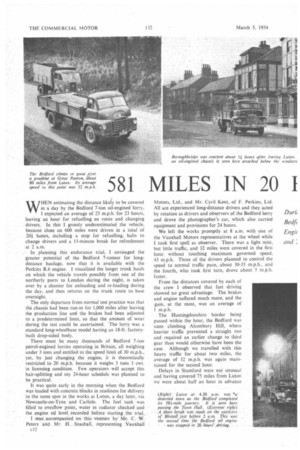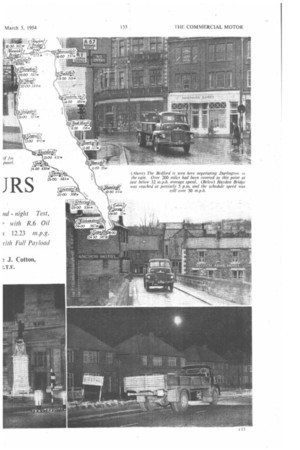581 MILES IN 20 1 JRS
Page 50

Page 51

Page 52

Page 53

If you've noticed an error in this article please click here to report it so we can fix it.
WHEN estimating the distance likely to be covered in a day by the Bedford 7-ton oil-engined lorry. I expected an average of 25 m.p.h. for 23 hours. leaving an hour for refuelling en route and changing drivers. In this I grossly underestimated the vehicle, because close on 600 miles were driven in a total of 204 hours, including a stop for refuelling, halts to change drivers and a 15-minute break for refreshment at 2 a.m.
• In planning this endurance trial. I envisaged the greater potential of the Bedford 7-tonner for longdistance haulage, now that it is available with the Perkins R.6 engine. I visualized the longer trunk hauls on which the vehicle travels possibly from one of the northerly ports to London during the night, is taken over by a shunter for unloading and re-loading during the day, and then returns on the trunk route to base overnight.
The only departure from normal test practice was that the chassis had been run-in for 1,000 miles after leaving the production line and the brakes had been adjusted to a predetermined limit, so that the amount of wear during the test could be ascertained. The lorry was a standard long-wheelbase model having an 18-ft. factorybuilt drop-sided body.
There must be many thousands of Bedford 7-ton petrol-engined lorries operating in Britain, all weighing under 3 tons and entitled to the speed limit of 30 m.p.h., yet, by just changing the engine, it is theoretically restricted to 20 m.p.h. because it weighs3 tons 3 cwt, in licensing condition. Few operators will accept this hair-splitting and triy 24-hour schedule was planned to be practical.
It was quite early in the morning when the Bedford was loaded with concrete blocks in readiness for delivery to the same spot in the works at Luton, a day later, via Newcastle-on-Tyne and Carlisle. The fuel tank was filled to overflow point, water in radiator checked and the engine oil level, recorded before starting the trial.
I Was: accompanied on this venture by. Mr. 'C. • W. Peters and Mr. H. Snashall, representing Vauxhall
(.12 Motors, Ltd.. and Mr. Cyril Kent, of F. Perkins, Ltd. All are experienced long-distance drivers and they acted by rotation as drivers and observers of the Bedford lorry and drove the photographer's car, which also carried equipment and provisions for 24 hours.
We left the works promptly at 8 a.m. with one of the Vauxhall Motors representatives at the wheel while I took first spelt as observer. There was a light mist. but little traffic, and 32 miles were covered in the first hour without touching maximum governed speed. 43 m.p.h. Three of the drivers planned to control the speed to normal traffic pace, about 30-35 m.p.h.. and the fourth, who took first turn, drove about 5 m.p.h.
faster.
From the distances covered by each of the crew I observed that fast driving showed no great advantage. The brakes and engine suffered much more, and the gain, at the most, was an average of 1 m.p.h.
The Huntingdonshire border being
passed within the hour, the Bedford was soon climbing Alconbury Hill, where heavier traffic prevented a straight run and required an earlier change to third gear than would otherwise have been the case. Although we travelled with this heavy traffic for about two miles, the average of 32 m.p.h. was again maintained for the second hour.
Delays in Stamford were not unusual and having covered 75 miles from Luton we were about half an hour in advance
of schedule. I took over the wheel at this point, in stormy weather. The low axle ratio (6.8 to 1) afforded rapid top-gear pick-up from 15 m.p.h., thus avoiding a change to a lower gear. Although this axle ratio may be best suited to general requirements, I would advocate the alternative of 5.83 to 1 for normal trunk operation, because it might reduce the rate of engine wear and would certainly improve the fuel consumption.
The Yorkshire border, just before Bawtry and 127 miles from Luton, was passed in 3 hr. 58 min., the average speed to this point being a fraction under 32 m.p.h., including a stop to change drivers. Doncaster at noon was fairly crowded, causing slight delay, and shortly afterwards the indirect gear ratios were required to climb the 1-in-101 gradient of Wentbridge Hill. By 1 p.m. we had reached Hook Moor, where the second change of driver was made, the average speed to that point being 31.6 m.p.h.
There were several rain showers during the afternoon, which disclosed a slight leak in one of the panels of the windscreen, but otherwise the Bedford cab was weatherproof and free from draught. It was comfortably warm, hut no heat was escaping from the engine cowl, which is doubled-skinned, and the floor temperature was below normal. In recording temperatures, all observers noted that the radiator meter showed " cold " for the entire 20 hours, which suggests that partial blanking would have been beneficial.
el4 Another two-mile obstruction was experienced north of Darlington while following a three-tractor outfit hauling an 82-ton load. Third gear was required for the gradients at Ferryhill and the slope to the Cock o' North at Chester Moor. The next change of crew, on the outskirts of Newcastle, saw also a change in weather, rain being replaced by,a strong and cold wind.
After negotiating Newcastle there was occasional use of the indirect gears when descending into East Denton, on the A69 road to Carlisle, and when climbing a gradient at Walbottle. Various inclines in the next 12 miles required third gear, and I was apprehensive that the fuel supply might fail after 300 miles had been covered before reaching Carlisle.
We entered the town in a blizzard and with some difficulty located the refuelling point. The route map indicated 310 mites, but the Bedford mileometer showed 305 miles. I consider the A.A. route mileage to be correct. Precisely 24 gallons of oil fuel were added to refill the tank. This gives an average of 12.7 miles per gal., assuming the vehicle mileometer to be correct.
It took 11 minutes to refuel, during which oil and water levels were checked, but no replenishment was required. After leaving Carlisle the snow turned to sleet, but when I took over at Penrith it was snowing again. I did not relish the descent of Shap in such weather, but fortunately after leaving the village the road was dry.
To test for brake fade, third gear was used and the speed held at 20 m.p.h. by braking. This was my first encounter with the notorious Shap, so I occasionally
applied full pressure on the pedal to make sure that, if necessary, there was sufficient retardation to change to a lower gear.
The brakes survived the test satisfactorily_ Increased pedal travel was to be expected, but no evidence was found of fade or glide and the pedal travel returned to normal within 12 minutes. The average speed for this hour fell to 17 m.p.h.
A few mistakes were made in map reading after dark, the first being in Kendal, when it was discovered we were on the A65 road. The main road to the south• was rejoined near Carnforth without materially affecting the overall mileage. Lancaster was reached just before 9 p.m., when I took post as observer, with Peters at the wheel.
For the next 50 miles to Preston, Wigan and Warrington the road was level and had it not been for a sixminute delay at the Latchford swing bridge, the average speed would again have been in excess of 30 m.p.h. Difficulties were encountered in locating the A537 road in Knutsford, with slight delay. Thereafter the route became hilly and the low axle ratio was found to be of advantage, third gear sufficing for all the gradients.
Ashbourne was reached at 12.30 a.m. and Cyril Kent, who was driving at the time, used second gear for the 1-in-12 descent out of the town, We drove through Derby just before 1 a.m. and at 1.50 a.m. a 15-minute break was made at Birstall for refreshment. By this time 508 miles had been covered in 18 hours, affording 28.2 m.p.h. overall average to the end of the break.
Leicester was reached about an hour later and at 3.12 a.m. the Bedford was climbing out of Kettering in third gear. The final change of crew was made here and 1 drove back to Luton. There was a two-minute delay in Bedford, where the local police inquired the reason for the vehicle being on the road at such an hour, but the works entrance was passed by 4.30 a.m.
12.23 m.p.g. for 581 miles The lorry was refuelled with 23-i gallons, providing an average of 1223 m.p.g. for the 58I-mile journey. The A.A. route map indicated 587i miles, without the inadvertent diversions made during the night. The oil and water levels had not altered.
Both axles were jacked up to measure brake-facing wear and to adjust the braking system. There was no measurable degree of wear, and one adjuster was taken up two notches, and the remainder one notch, to bind the drums. Clearly, the vehicle could complete at least seven days' work of similar severity before any adjustment might be deemed necessary, The Bedford showed itself to be a good trunk-haulage lorry, able to keep its place with heavier models, and capable of covering many more miles in a given time. The fuel-consumption rate of 12i m.p.g. for hard driving and low operating temperatures is not unreasonable. especially as a 7-ton payload was carried all the time. After deducting the time of all stops, the average speed worked out to 29.8 m.p.h.
At daybreak the Bedford was again on the road for acceleration and braking trials. , My impression of its performance was confirmed in reaching 30 m.p.h. from rest in 32.8 sec., and improvements in the braking system, with hydraulic operation to all four wheels, were reflected in the unusually short stopping distance of under 40 ft. from 30 m.p.h.




































































































